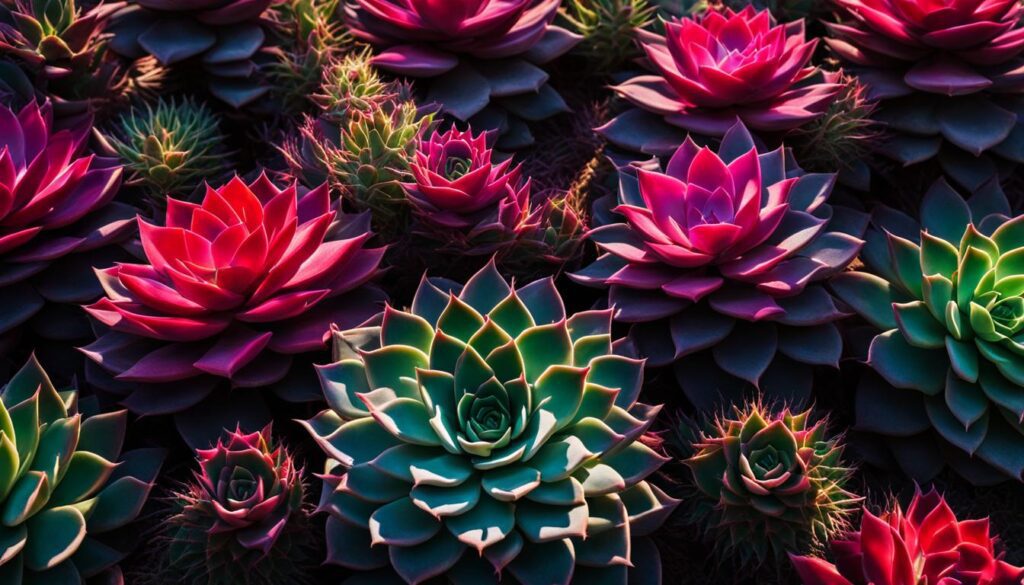Have you ever wondered why your succulents change color? These intriguing and aesthetically pleasing plants are known for their ability to alter their pigmentation in response to environmental stress. Factors such as sunlight, temperature, and water stress can result in a succulent color change. While it may seem concerning, this phenomenon is actually a survival mechanism rather than an indication of poor health.
Key Takeaways
- Succulent pigmentation changes are driven by environmental stress factors.
- Exposure to sunlight can influence succulent color variation, with early morning sun being ideal for vibrant hues.
- Temperature variations play a significant role in altering the color of succulents, with cooler temperatures often leading to more vivid pigmentation.
- Over-watering can wash out succulent colors, while controlled water stress could enhance their color palette.
- Monitoring and managing environmental factors can help gardeners maintain and enrich the vibrancy of their succulents.
Uncovering the Natural Phenomenon of Color Variation in Succulents
Succulent plants exhibit a wide range of color variations due to environmental changes. These adaptive pigmentation responses are not indications of harm, but rather, stress adaptations that help succulents survive in their respective environments. In this section, we will explore the factors that contribute to the stress-induced color change in succulents and examine the types of pigments responsible for these remarkable transformations.
Environmental factors, such as watering frequency, sunlight exposure, and temperature variations, can all influence a succulent’s pigmentation. Some succulents may display color changes only on the rim of their leaves rather than the entire plant, and these adaptations can occur even with proper care. For instance, succulents exposed to sudden environmental stress, including changes in sunlight, water, or temperature, can display a variety of red, orange, and purple tones.
The production of pigments like carotenoids and anthocyanin is the underlying mechanism for these color changes. These pigments serve as essential protective measures for succulents against intense light, contributing to their overall resilience and longevity. The table below outlines the primary pigments found in succulents and their associated functions:
| Pigment | Color | Function |
|---|---|---|
| Chlorophyll | Green | Plays a vital role in photosynthesis by capturing light energy and converting it into chemical energy |
| Carotenoids | Yellow, orange, red | Protects plants from excessive light by absorbing and dissipating excess energy, also functions as antioxidants |
| Anthocyanin | Red, blue, purple | Protects plant tissues from harmful UV radiation and oxidative stress, also functions as an antioxidant |
As a succulent enthusiast, it is essential to understand that these environmental influences on succulent color are natural and even beneficial in some instances. By acknowledging the role of stress-induced color change in succulents, you can better appreciate the captivating diversity within your succulent collection and apply appropriate care techniques to maintain and even enhance their pigmentation.
Factors to consider when caring for succulents include:
- Regulating watering frequency to prevent over- or under-watering
- Adjusting sunlight exposure to provide optimal light conditions
- Monitoring temperature fluctuations to avoid extreme temperature stress
In the following sections, we will delve deeper into the effects of sunlight, temperature, and watering on succulent pigmentation, providing practical tips to help you preserve and enhance the color of your plants. By fine-tuning your succulent care regimen, you can foster an even more vibrant and diverse collection of these fascinating plants.
The Impact of Sunlight on Succulent Pigmentation
Morning sunlight and succulents have a special relationship that can directly impact their color vibrancy. By understanding the ideal sun exposure for succulents, you can harness the sunlight’s influence and maximize your plants’ pigmentation.
Early Morning Sun Exposure: The Best Practice for Vibrant Hues
Providing your succulents with early morning sunlight followed by afternoon shade is a proven technique for enhancing their color. This ensures the plants receive the optimal balance of light, which prevents them from scorching while allowing them to express their full color potential.
Indoor vs. Outdoor: Understanding Light Requirements for Colorful Succulents
Indoor succulents typically appear darker green due to reduced sunlight, while outdoor succulents can exhibit more vibrant hues. Adapting and adjusting your succulents’ environment is crucial to their overall health and pigmentation:
- Indoor succulent light requirements: Ensure that your indoor succulents are provided with bright, indirect sunlight to prevent etiolation.
- Outdoor succulent pigmentation: Outdoor succulents benefit from morning sunlight and afternoon shade, encouraging their brilliant, natural coloration.
Adapting to Different Sunlight Conditions: Transition Tips for Maximum Color
When transitioning succulents to sunlight, it’s essential to make the process as gradual and stress-free as possible to avoid light shock. Implement these tactics for a successful and colorful transition:
- Light stress adjustment in succulents: Gradually increase their sun exposure over one to two weeks to reduce the risk of light stress.
- Transitional locations: Start by placing your succulents in bright shade and progressively move them to partial sun as they acclimate.
- Monitor and adjust: Keep an eye on your transitioning succulents for signs of too much or too little light, making adjustments as needed to achieve the desired succulent color enhancement.
Temperature Fluctuations and Their Role in Succulents’ Color Transformation
Succulents are sensitive to temperature fluctuations, which can dramatically affect their coloration. Elevated temperatures and increased sunlight exposure can lead to succulents developing red tips or other changes in hue. Conversely, lower temperatures can result in more intense pigmentation, particularly noticeable during the cooler months.
Temperature-induced color change in succulents is a common phenomenon, with both cold and heat stress on succulents contributing to their unique pigmentation. Succulents respond to temperature changes by producing specific pigments in an effort to protect themselves. These pigments, such as carotenoids and anthocyanins, create the vivid colors that make succulents so visually appealing.
Let’s take a closer look at how different temperature ranges can influence the coloration of succulents:
| Temperature Range | Color Changes |
|---|---|
| High Temperatures | Red tips, hues of orange, and muted colors |
| Moderate Temperatures | Minimal color change, often maintaining a green appearance |
| Low Temperatures | Intensified pigmentation, with shades of pink, purple, and blue |
It is crucial to monitor your succulents’ response to temperature changes, as prolonged exposure to extreme conditions can lead to stress and potential damage. When caring for your plants, consider the following recommendations:
- Keep your succulents in an area with stable temperature conditions, avoiding locations with drastic fluctuations.
- Provide adequate shade during the hottest part of the day to prevent heat stress.
- Consider moving your succulents indoors during the coldest months, or provide them with a frost cover for protection against the cold.
- Gradually acclimate your succulents to new temperature conditions, to minimize stress and promote healthy color transitions.
By understanding the effects of temperature fluctuations on your succulents’ coloration, you can make informed decisions about their care and create the perfect environment for them to thrive. Additionally, taking the necessary precautions will ensure the health and well-being of your succulent collection while preserving and enhancing their beautiful colors.
Watering Practices: The Delicate Balance Between Hydration and Color Intensity
Watering succulents is crucial for their survival, but finding a balance between proper hydration and maintaining color intensity requires careful attention. In this section, we’ll explore how over-watering can result in color loss, the surprising effects of water stress on colors, and strategic watering techniques to enhance your succulents’ color palette.
How Over-Watering Can Wash Out Succulent Colors
The over-watering effects on succulents can be quite detrimental, causing root rot and sometimes even plant death. However, another lesser-known effect of excessive watering is succulent color loss due to watering. Over-watered succulents tend to exhibit a predominately green appearance, which may be less visually appealing to some gardeners. To maintain succulent color through watering practices, it is essential to water adequately without oversaturating the soil.
The Surprising Effects of Water Stress on Succulent Colors
While over-watering can wash out the vibrant hues of succulents, it can be surprising to learn that water stress in succulents can actually result in more intense colors. When a succulent experiences color changes due to under-watering, these shifts are actually a sign of water-induced stress and succulent pigmentation adaptation. However, care should be taken to ensure that dehydration is not prolonged, as this may harm the plant in the long run.
Strategic Watering Techniques to Enhance Your Succulents’ Color Palette
To care for color enhancement in your succulents, it is vital to develop strategic watering for succulent pigmentation. By employing specific watering techniques for colorful succulents, it is possible to strike an ideal balance between hydration and color intensity. Here are some tips to help you achieve this balance:
- Monitor the moisture level in the soil before watering your succulents, ensuring it has dried out completely before administering more water.
- Water your succulents less frequently during cooler months, as their water requirements are generally lower during this time.
- Gradually adjust watering frequency to experiment with color changes, but always remain cautious to avoid causing harm to the plant.
- Pay attention to your plant’s appearance and adjust your watering practices accordingly, finding the perfect balance between hydration and color intensity.
By tailoring your watering practices to each succulent’s needs, you can help maintain and enhance their vibrant colors while ensuring their overall health and well-being.
How Does the Color Change in Succulents Affect Their Use in Christmas Ornaments?
Succulent Christmas ornaments are gaining popularity due to their unique color-changing abilities. As the temperature drops, succulents can change their colors, making them perfect for holiday decorations. The vibrant hues add a festive touch to any Christmas decor, making these ornaments a standout choice for festive celebrations.
Unlocking the Secrets to Vibrant Succulents
As a succulent aficionado, you likely appreciate the various hues these resilient plants can display. Achieving and maintaining the most vibrant colors requires a keen understanding of the factors influencing succulent pigmentation. In this article, we explored how environmental stressors such as sunlight, water, and temperature can lead to color changes in your succulents, making them a stunning focal point in your home or garden.
To truly enhance your succulents’ colors, emphasize giving them the proper morning sunlight exposure. Strategically adjusting your watering practices may contribute to managing stress-induced pigmentation, ensuring their color palette remains vivid and diverse. Be mindful of the effects temperature can have on your succulents, and observe how fluctuations can create dynamic color transformations.
By implementing the best practices for colorful succulents and giving attention to each plant’s unique needs, you can happily showcase a collection that boasts an impressive spectrum of hues. Continuously monitor the wellbeing of your succulents, striking the delicate balance between eliciting beautiful colors and maintaining their overall health. With patience and dedication, you’ll be rewarded with an extraordinary display of ever-changing colors that bring life and natural beauty to your surroundings.












